| JANUARY 2024 |
|
6 shows in T˘ky˘ (Kabukiza, New National Theatre, Asakusa K˘kaid˘, Shinbashi Enbuj˘), 4 in ďsaka (Sh˘chikuza, ďsaka Club) and 1 in Ky˘to (Ky˘to Gekij˘)!
|
| Kabukiza (T˘ky˘) |  |
| Dates | 2 ~ 27 January 2024 Kotobuki Hatsuharu ďkabuki Congratulation Early Spring Grand Kabuki |
| MatinÚe |
Ataru Tatsudoshi Kabuki no Nigiwai
|
| Evening | |
| Casting |
Living National Treasure Nakamura Baigyoku, Living National Treasure Nakamura T˘z˘, Matsumoto Haku˘, Nakamura Kaishun, Nakamura Jakuemon, Nakamura Shikan, Nakamura Fukusuke, Matsumoto K˘shir˘, Nakamura Ganjir˘, Nakamura Senjaku, Onoe Sh˘roku, Nakamura Kinnosuke, Ichikawa Chűsha, Nakamura Matagor˘, Band˘ Yajűr˘, Nakamura Kazutar˘, Ichikawa Komaz˘, Onoe Ukon, Band˘ Kamez˘, Matsumoto Kingo, Ichikawa En'ya, Ichikawa Seiko, Nakamura Matsue, Nakamura Kikaku, Sawamura S˘nosuke, ďtani Keiz˘ Nakamura Takanosuke, Nakamura Toranosuke, Ichikawa Somegor˘, Nakamura Fukunosuke, Nakamura Utanosuke, Nakamura Tamatar˘, Onoe Sakon, Nakamura Kichinoj˘, Nakamura Baika |
| Comments |
The two programs for the New Year Grand Kabuki at the Kabukiza.
|
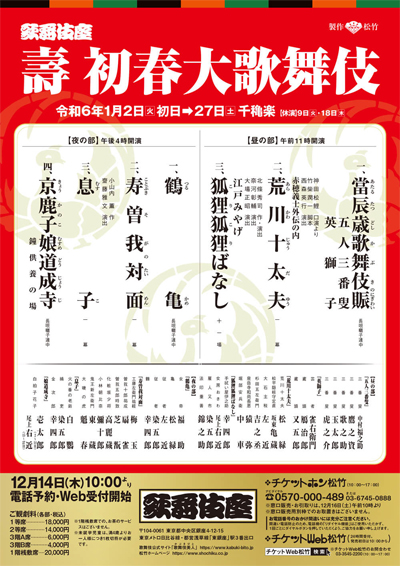 |
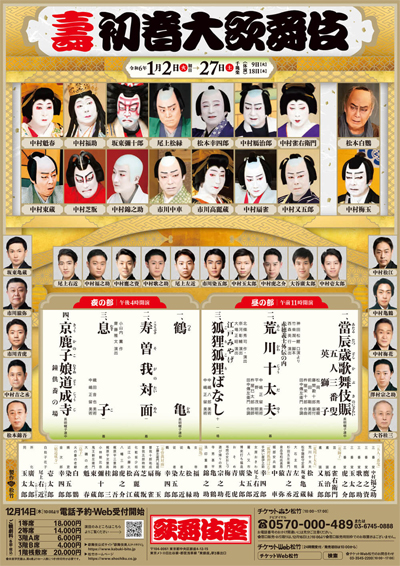 |
| New National Theatre (T˘ky˘) |  |
| Dates | 5 ~ 27 January 2024 |
| Program |
Kajiwara Heiz˘ Homare no Ishikiri |
| Casting |
Living National Treasure Onoe Kikugor˘, Nakamura Tokiz˘, Onoe Kikunosuke, Band˘ Hikosabur˘, Nakamura Baishi, Kataoka Kamez˘, Ichimura Manjir˘, Kawarasaki Gonjűr˘, Nakamura Mantar˘, Ichimura Takematsu, Onoe Ushinosuke, Onoe Maholo, Ichimura Hikaru, Band˘ Kamesabur˘, Arashi Kitsusabur˘, Ogawa Hiroharu
|
| Comments |
No performance at the National Theatre, which will be destroyed and rebuilt, in 2024 but there will be a subsitute theater: the New National Theatre! For the very first in the history of this theater dedicated to opera, ballet or modern dances/dramas, there are Kabuki performances in its playhouse! |
 |
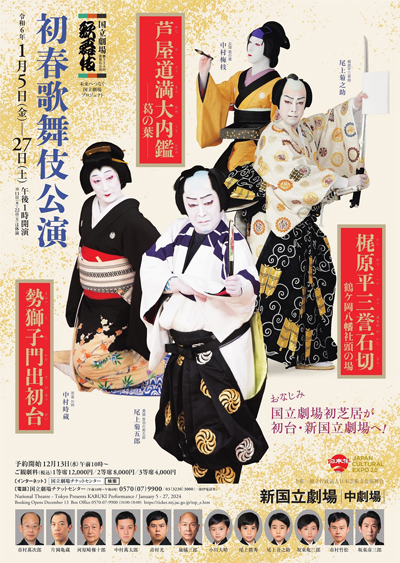 |
| Sh˘chikuza (ďsaka) |  |
| Dates | 3 ~ 14 January 2024 Band˘ Tamasabur˘ Hatsuharu Otoshidama K˘en Band˘ Tamasabur˘ Early Spring New Year's Gift Performances |
| Program |
Kurokami Yukari no Tsuki |
| Casting |
Living National Treasure Band˘ Tamasabur˘ |
| Comments |
A special Buy˘ program in ďsaka at the Sh˘chikuza starring the amazing Living National Treasure onnagata Band˘ Tamasabur˘.
|
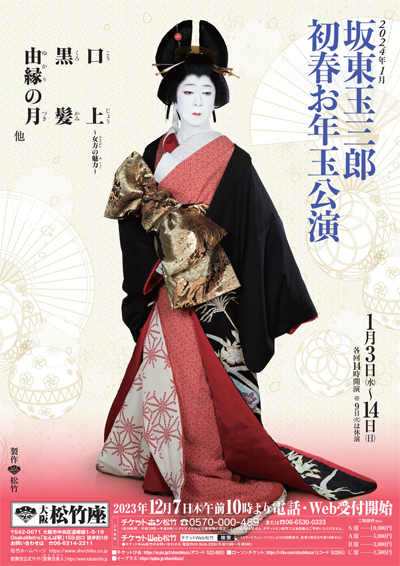 |
| Dates | 18 ~ 20 January 2024 Band˘ Tamasabur˘ Haru no Hitotoki Band˘ Tamasabur˘ Spring Time |
| Program |
Koshiji Fubuki Monogatari Shibahama Yuki |
| Casting |
Living National Treasure Band˘ Tamasabur˘ |
| Comments |
A special program starring Living National Treasure onnagata Band˘ Tamasabur˘ in ďsaka at the Sh˘chikuza with the rakugo storyteller Shunpűtei Koasa.
|
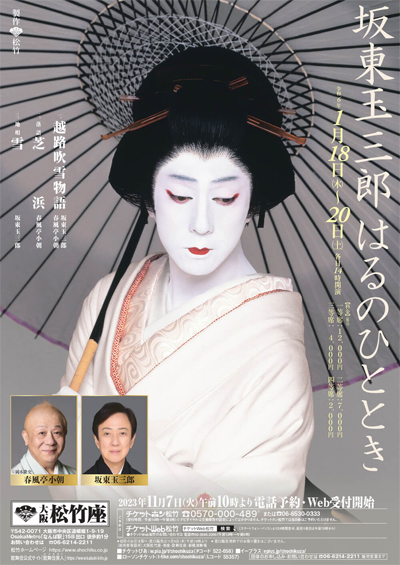 |
| Dates | 22 ~ 28 January 2024 Night KABUKI in Osaka Dotonbori |
| Program |
Kabuki no Mikata |
| Casting |
Kataoka Senju, Kataoka Senjir˘, Kataoka Aizabur˘ |
| Comments |
A special program entitled in English and starring Kataoka clan's disciples.
|
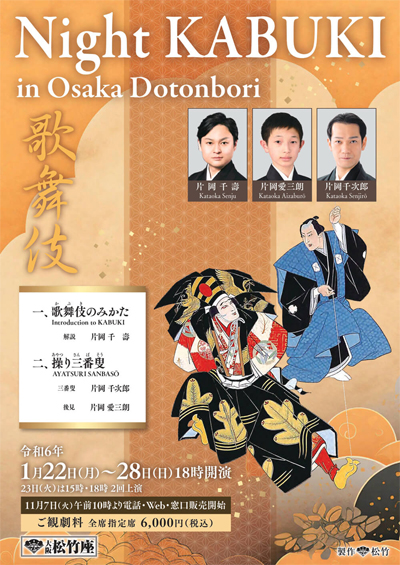 |
|
|||
| Dates | 2 ~ 26 January 2024 Shinshun Asakusa Kabuki New Year Asakusa Kabuki |
||
| MatinÚe |
Otoshidama (Nenshi Goaisatsu) |
||
| Evening |
Otoshidama (Nenshi Goaisatsu) Ichi-no-Tani Futaba Gunki (Kumagai Jin'ya) Ryűsei |
||
| Casting |
Living National Treasure Nakamura Karoku, Band˘ Minosuke, Nakamura Hayato, Onoe Matsuya, Nakamura Yonekichi, Band˘ Shingo, Nakamura Kash˘, Nakamura Hashinosuke, Nakamura Tanenosuke, Nakamura Kangyoku, Ichimura Kitsutar˘, Nakamura Kamenoj˘, Nakamura Kichinoj˘ |
||
| Comments |
The yearly show for young promising actors at the Asakusa K˘kaid˘ in Asakusa, a lively and colorful neighboorhood that keeps the scent of old Edo.
|
||
 |
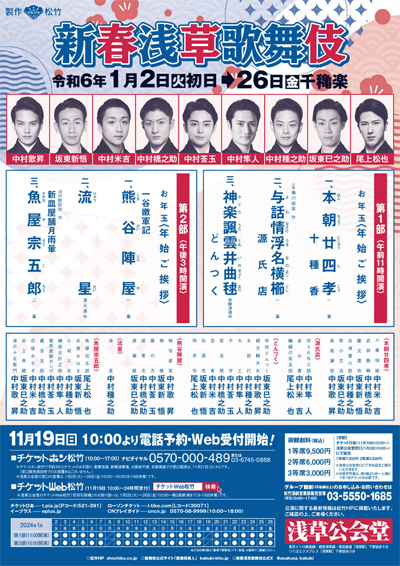 |
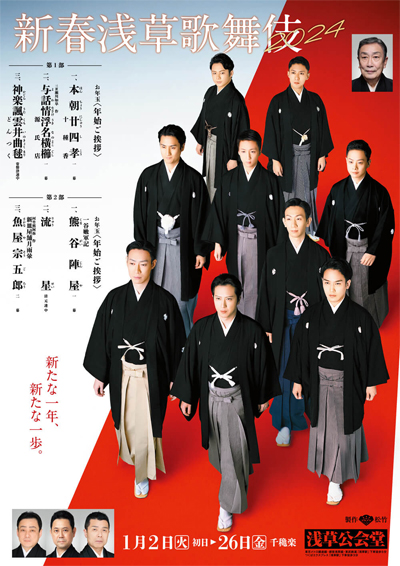 |
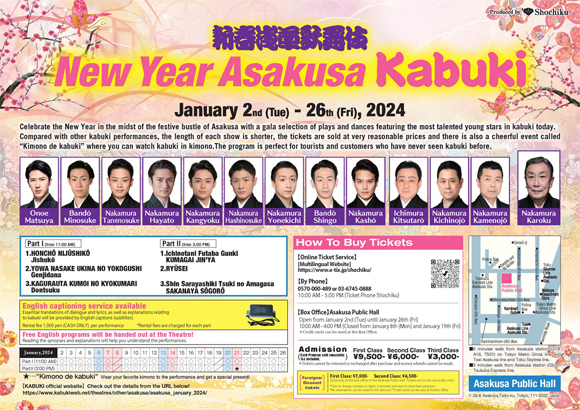 |
| Shinbashi Enbuj˘ (T˘ky˘) |  |
| Dates | 6 ~ 25 January 2024 Hatsuharu Kabuki K˘en Early Spring Kabuki Performances |
| Program |
Heike Nyogo no Shima |
| Casting |
Ichikawa Danjűr˘, Ichikawa Udanji, Kataoka Takatar˘, Nakamura Kotar˘, ďtani Tomoemon, Kataoka Ichiz˘, Ichimura Kakitsu, Ichikawa Omez˘, Ichikawa Kudanji, Ichikawa Shinnosuke, ďtani Hiromatsu, Ichikawa Otora, Ichikawa Botan |
| Comments |
The traditional New Year Kabuki at the Shinbashi Enbuj˘ with a troupe led by Ichikawa Danjűr˘. |
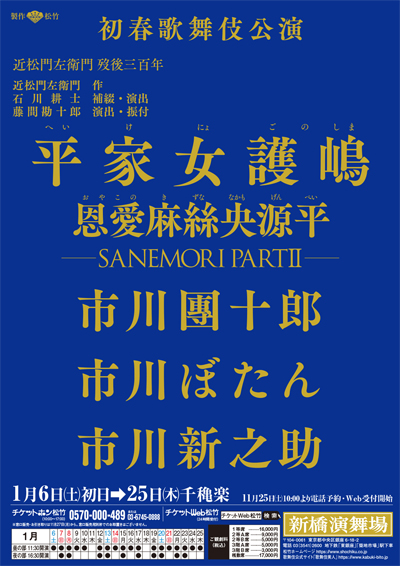 |
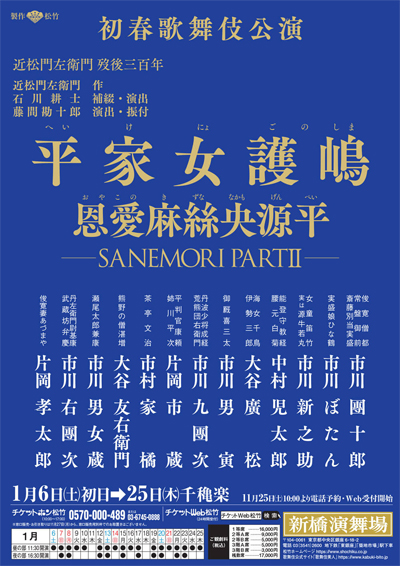 |
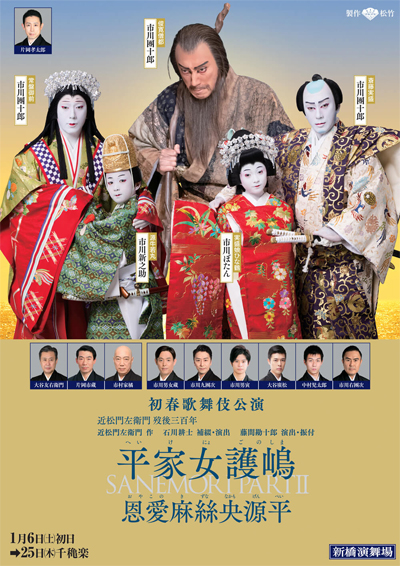 |
|
|||
| Dates | 6~ 14 January 2024 Zenshinza Tokubetsu K˘en Zenshinza Special Performances |
||
| Program |
Shin Sarayashiki Tsuki no Amagasa Shichifukujin Takara no Irifune |
||
| Casting | |||
| Comments |
The traditional Zenshinza New Year performances in Ky˘to. Not at the Minamiza, as it used to be, but at the Ky˘to Gekij˘. |
||
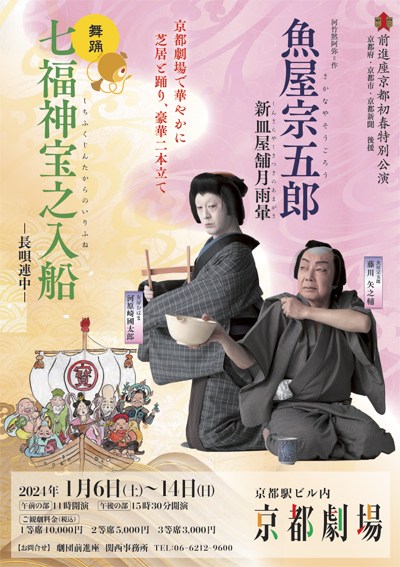 |
| ďsaka Club (ďsaka) |  |
| Dates | 29 January 2024 Kamimura Kichitar˘ Kabuki no Miryoku Kamimura Kichitar˘ and the Enchantment of Kabuki |
| Program |
Matsu no Sanbas˘ T˘ku & RekuchÔ Kamimura Kichitar˘ Kabuki no Miryoku |
| Casting | |
| Comments |
A special Buy˘ gala program in ďsaka at the ďsaka Club starring the young Kamigata actor Kamimura Kichitar˘. The first item is a sanbas˘mono perforemed in suodori. The second item is a talk & lecture about the Enchantment of Kabuki. |
 |
|
|
| Contact | Main | Top | Updates | Actors | Plays | Playwrights | Programs | Links | FAQ | Glossary | Chronology | Illustrations | Prints | Characters | Derivatives | Theaters | Coming soon | News |
